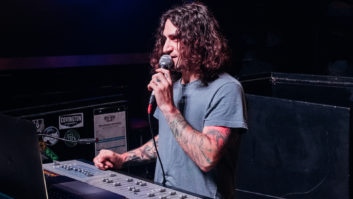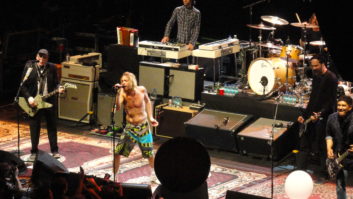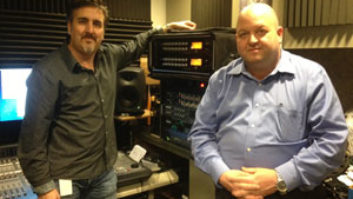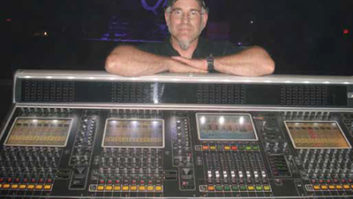On a weekday afternoon in July, rows of chairs line the main floor of the Hammerstein Ball-room, a giant projection screen hovers in the stage house and a multicolored display of Macintosh computers command the stage, all in preparation for a technology convention. It’s a far cry from the way the hall looks when it’s invaded by thousands of music fans rocking out to Godsmack or grooving to Moby.
“The face of this room can change on a dime,” declares Victor Moore, VP of audio sales and production at Manhattan Center Studios. “You can walk in here [for different events] and go, ‘Is this the same place?’ Pratt Institute [recently] held a big display of their art. If you had come during that time, you wouldn’t have recognized it. The room was subdivided into 30 sections.”
From sweaty, gritty rock shows to chic corporate events and lavish holiday parties, the Hammerstein Ballroom hosts a wide range of events. And its history is every bit as diverse.
FOLLOWING THE LINEAGE
Opera impresario and theater builder Oscar Hammerstein constructed the Ballroom, originally christened the Manhattan Opera House, in 1906 to compete with the Metropolitan Opera and create a venue where everyday people could enjoy that musical art form. He was successful during the four years that the concert hall was in business, luring patrons away from the Met and affecting that institution’s income for the first time. Then in 1910, the Met offered Hammerstein $1.2 million to stop putting on operas for a decade. He accepted.
The Opera House then changed hands several times — serving as a vaudeville hall and later a “talkie” movie theater — until the 1920s, when it was purchased by the Scottish Rites of Free Masonry, who made major renovations and built the 1,200-person-capacity Grand Ballroom on the seventh floor, or what was once the roof. During the mid-1930s, Abraham Ellis, the former concessionaire at the Opera House, purchased it. He changed the name to the Manhattan Center, reduced the size of the main stage downstairs and sealed off the third balcony from the public.
“When they turned this into a ballroom, they actually lost this ceiling,” points out Robert Carvell, director of production services. “They hung a ceiling below that proscenium, all the way across, and cut off the third balcony and cut off all that empty, open space up there near the ceiling.”
The refurbished venue became popular for big band performances, union meetings and trade shows. During the following decades, management gradually let the facility slip into a state of disrepair. The venue eventually closed in the mid-1970s, but then Manhattan Center Studios Inc., a subsidiary of One-Up Enterprises, took it over.
“We’ve been here for 25 years,” reports Randy Davis, president of Manhattan Center Studios, “and since then started building audio rooms, video rooms and post-production suites, with these two big ballrooms as the core of our facilities.” His company has transformed the Hammerstein Ballroom into one of the premier live music venues in New York City.
The current capacity of the Hammerstein is 3,700 when the audience is standing. The floor holds 2,500, and each of the two open balconies holds 600 seated patrons. When there are seats on the main floor, 1,200 people can sit there, reducing the overall capacity to 2,500. The third balcony is closed to the public, but the lower ceiling was removed, once again revealing beaux-arts angels flying on ceiling frescos high overhead.
The Hammerstein hosts many seated shows, from award ceremonies (the Tamika Reggae Awards and the Rhythm & Blues Foundation Pioneer Awards) to launch parties (Microsoft and Lexus). But music is still what the public comes to hear. “When you see concerts here, you’re not far away from the show,” observes Moore. “[Even in] the balcony, you’re close to the show.” Both open balconies are low and at shallow angles, so fans can avoid the unpleasant “nosebleed” feeling common to other concert venues.
Carvell reports that the Hammerstein’s plaster ceiling is 75 feet high, and the grid height in the stage house is 85 feet. The building itself is solid brick on the outside, plaster inside, and the structure is steel.
“It’s kind of a unique room, because the actual room itself traverses both the front of house and stage house,” Carvell explains. “We have a small, hard stage now in the stage house, which is 24 feet deep by 54 feet wide. We have additional staging to build that out up to 40 feet deep, and, if necessary, we can bring in an extra stage to fill the whole stage house. It’s an enormous stage if you do that. The proscenium is almost in the middle of the room. It was built for opera — major fly space, big stage.”
Soundwise, the Hammerstein is well-stocked with some powerful equipment. Mixers have the option of a 40-channel Crest VX or a Yamaha 01V digital unit. The venue offers a wide range of Turbo-sound cabinets, including 20 TSW-721s (bass), 18 TFL-760 Floodlights (mid/high) and eight THL-2s (full-range), all powered by QSC Powerlight amplifiers. It also has 12 EAW KF300 cabinets, seven Apogee cabinets (four AE-2 subs and three AE-5 full-range) and 14 Meyer cabinets (10 UPA full-range and four subs).
“We have found that the Turbo-sounds are very good for concerts,” says Carvell. “It’s really full, good-quality sound. For a lot of the more corporate events or talking-head things, we’ve found that the EAWs work very nicely to distribute the sound. As you see, we’ve got sound all the way around the sides. We’ve got a couple of speakers up front as well. You have very good coverage all around.”
Carvell points out that because the Hammerstein was originally designed as an opera house, it has very good acoustics. “It’s been changed, and a flat floor has been put in, so that did make a little bit of impact,” he says. “But the acoustics have been sampled for one of the [E-mu] reverb units.”
BACK IN THE CONTROL ROOM
Those acoustics are put to good use in a live forum, and the Hammerstein is well equipped to record shows in multiple formats, from CD to DVD. “All of our facilities have tielines to this room, so we can record in the various formats,” explains Moore, referring to Manhattan Center Studios’ three audio recording studios, two video control rooms and two digital online video editing suites (with D2 and DigiBeta formats).
“It’s kind of like Noah’s Ark,” he quips. “Two of everything basically, just in case.” Studio 7 has a Neve VR 96 console with 120 inputs, and it is the main room used for live recordings in the Hammerstein. Studio 4 has a Neve VR 72, and Studio 8 has a 72-channel Mackie console that is often used for Pro Tools work and tracking. Studios 1 and 6 are the video control rooms with adjacent stage areas.
Because the Ballroom is literally plugged into Manhattan Center Studios’ recording facilities, artists and labels are able to record a show in multiple formats. Such a multiform event transpired recently when reggae legend Beres Hammond performed and recorded a Pay-Per-View special.
A multicamera shoot was done for a forthcoming album, home video and DVD. “We did the stereo mix for the album, we did the 5.1 surround mix in [Studio 7], which is set up for 5.1 recording and mixing since we do so much film stuff,” Moore says. “The thing about our rooms is, we’ve been doing film work for 10 years, so we’re ahead of the game with mixing 5.1, because we know and understand how to set up and mix in that format.”
The video shoot was coordinated from the sixth-story video control room, which is an analog room with a Grass Valley 250 switcher and Sony Betacam machines. “For the music stuff, we’ll almost always take a feed from Studio 7 direct to the Beta machines,” Davis explains. “So we’ll do two or three different audio recordings. We’ll do it on DAT, often we’ll do a digital recording as well on our 3348 machines, and record it directly to the Beta machines. Having the different formats and capabilities makes it that much easier for our clients, being that we can do all of that in one facility.”
Video shoots at the Hammerstein can expand to as large as eight to 10 cameras. “We’ve done everything from the Oprah Winfrey Show — when her guests were Janet Jackson and Paul McCartney on two different days — to HBO Boxing in the Hammerstein,” remarks Davis. “Even just smaller, single-camera product shoots and music videos and the Top of the Pops for Germany. We have fiber lines throughout the building, as well as fiber lines connecting us to satellite transmissions.” One of their clients worked with Aaliyah and wanted a live performance transmitted to the German Top of the Pops. “They did it live here and sent the signal live to Germany, so they did a downlink there to be able to show that live in prime time.”
From audio to video, one of Hammerstein’s most distinguishing factors is its diversity. The venue has held everything from “very high-end rock ‘n’ roll concerts to high-end parties,” says Moore. “Our location is unique. We’ve got access from subway stations to the Jersey tunnel. We’re between 8th and 9th Avenues on 34th Street in Manhattan. Penn Station’s there. We’re in a great setting.”
One wonders whether Oscar Hammerstein had any inkling of how his opera house would be transformed into an all-encompassing entertainment venue. The divas performing here today may be different from those at the turn of the century, but, ultimately, the ballroom still fulfills its purpose of bringing music to the masses in a lavish setting with superior acoustics.
For more information, log onto www.mcstudios.com.
Bryan Reesman is a freelance writer in the New York metro area.




